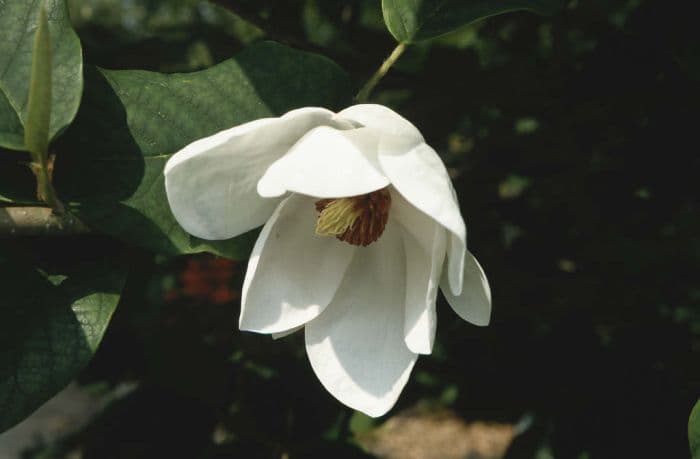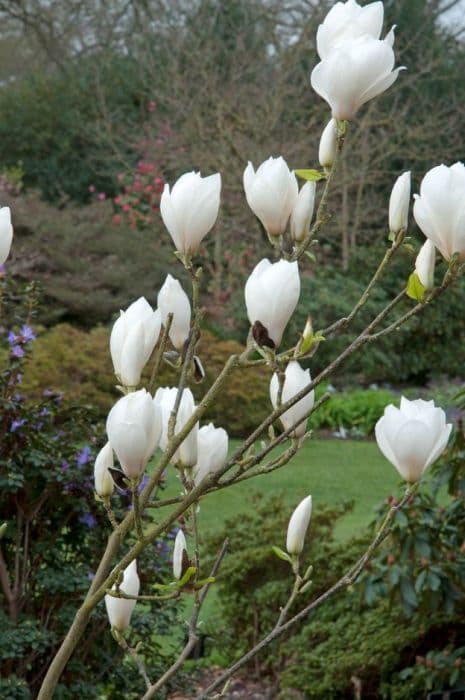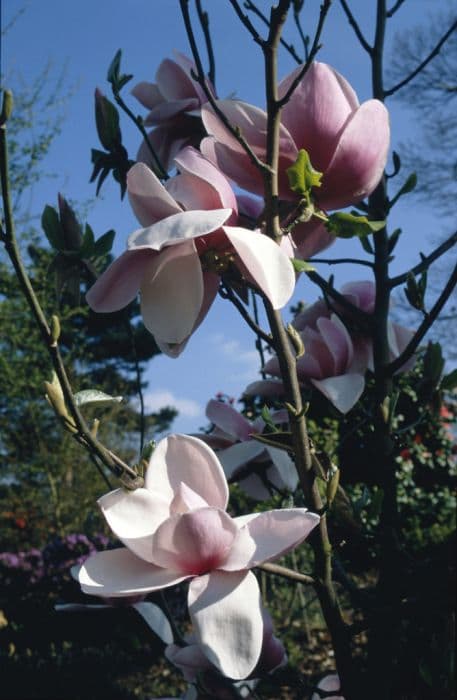Chinese Magnolia Vine Magnolia sieboldii subsp. sinensis

ABOUT
Magnolia sieboldii subsp. sinensis, commonly known as the Chinese magnolia, is a captivating plant admired for its aesthetic appeal. It presents an elegant display of foliage and blooms that can enhance any garden or landscape. The leaves are green and have an elongated oval shape with a smooth texture which brings a lush look to the plantings. These leaves often serve as a perfect backdrop for the plant's most striking feature, its flowers. The blooms of the Chinese magnolia are especially noteworthy, characterized by their delicate and somewhat pendulous nature, a feature that sets it apart from other magnolias. Each flower consists of a set of white petals that gracefully cup around a central mass of contrasting stamens, often with a hint of a blush pink at the base and a prominent conical structure in the middle. The petals are large and come together to form a cup-like bloom which exudes an enchanting fragrance, especially on warm days or in the evening, adding a layer of sensory delight. The blossoms are not just visually appealing but are also frequented by pollinators like bees and butterflies, adding a sense of dynamism to the viewing experience. After the flowering period, the plant produces decorative seed pods which, upon maturity, crack open to reveal seeds warmly embraced by a bright red fleshy coating, adding to the plant's ornamental value. Overall, the Chinese magnolia is a desirable plant choice for those seeking aesthetic beauty and a touch of elegance, with its display of charming foliage and stunningly fragrant flowers that provide a magnificent spectacle without considering the plant's size.
About this plant
 Names
NamesFamily
Magnoliaceae.
Synonyms
Oyama Magnolia, Siebold's Magnolia, Chinese Magnolia.
Common names
Magnolia sinensis, Yulania sinensis.
 Toxicity
ToxicityTo humans
The common name for Magnolia sieboldii subsp. sinensis is Oyama magnolia. Oyama magnolia is not commonly known to be toxic to humans. There is limited information on the toxicity of Oyama magnolia to humans, and it is not typically regarded as a poisonous plant. Thus, there are no well-documented cases or significant concerns regarding the ingestion of its parts leading to poisoning in humans. However, as with any plant, individual allergies and sensitivities can occur, so it is always advisable to exercise caution and not consume parts of plants that are not generally recognized as edible.
To pets
The common name for Magnolia sieboldii subsp. sinensis is Oyama magnolia. Oyama magnolia is not widely recognized as a toxic plant for pets either. There is little to no information suggesting that exposure or ingestion of this plant will result in poisoning for common household pets such as dogs and cats. No specific symptoms or consequences are commonly associated with the ingestion of any part of Oyama magnolia by pets. Nonetheless, it's always a good practice to prevent pets from consuming plants not intended for their diet, as individual animals might have unique sensitivities or reactions.
 Characteristics
CharacteristicsLife cycle
Perennials
Foliage type
Deciduous
Color of leaves
Green
Flower color
White
Height
10-20 feet (3-6 meters)
Spread
6-15 feet (1.8-4.5 meters)
Plant type
Shrub
Hardiness zones
6
Native area
Asia
Benefits
 General Benefits
General Benefits- Aesthetic appeal: Magnolia sieboldii subsp. sinensis, often known simply as Siebold's magnolia, offers ornamental value with its large, showy flowers that can enhance the visual appeal of gardens and landscapes.
- Habitat for wildlife: The flowers provide nectar for pollinators such as bees and butterflies, while the seeds can attract various bird species, contributing to local biodiversity.
- Shade provision: As Siebold's magnolia matures, it can provide shade in gardens and parks, helping to reduce local temperatures and create comfortable outdoor spaces.
- Seasonal interest: With its distinctive and colorful blooms in spring and early summer, followed by fruiting in later seasons, Siebold's magnolia provides multi-season interest.
- Erosion control: The root system of Siebold's magnolia can help to stabilize soil, combatting erosion on slopes and in garden settings.
- Low maintenance: Once established, Siebold's magnolia requires relatively little care, making it a convenient choice for gardeners with limited time.
- Fragrance: The flowers emit a sweet fragrance that can add a sensory dimension to gardens, enhancing the overall outdoor experience.
- Cultural significance: In certain cultures, magnolias are associated with nobility and perseverance, adding an element of cultural or symbolic significance to the landscape where they are grown.
 Medical Properties
Medical Properties- Anti-inflammatory: Extracts from Magnolia sieboldii subsp. sinensis may have properties that reduce inflammation.
- Antioxidant: Components of the plant are believed to have antioxidative effects, which could help in protecting cells from oxidative damage.
- Antitumor: Some studies suggest the plant may possess antitumor properties, potentially inhibiting cancer cell growth.
- Antibacterial: There may be antibacterial compounds within the plant that help in combating bacterial infections.
- Anxiolytic: Magnolia sieboldii subsp. sinensis might also have compounds that could potentially exert anxiolytic effects, meaning it could help reduce anxiety.
- Neuroprotective: The plant may contain elements that have a protective effect on the nervous system.
 Air-purifying Qualities
Air-purifying QualitiesThis plant is not specifically known for air purifying qualities.
 Other Uses
Other Uses- Magnolia Sieboldii subsp. sinensis, commonly known as Chinese magnolia, can be used as a natural dye for fabrics, yielding various shades of greens and browns depending on the mordant used.
- The bark of the Chinese magnolia can be processed into a fine powder and used in incense for its aromatic properties.
- The wood of this plant is workable and can be used in the creation of small wooden crafts or decorative objects.
- Chinese magnolia petals can be crystallized and used as decorative and edible elements on desserts.
- The fibers from the bark have traditional use in paper-making for creating high-quality, textured paper.
- Extracts from the flowers are sometimes used in perfumery, adding a unique floral scent to fragrances.
- During bloom, the flower can serve as an indicator of seasonal changes in horticulture and educational displays.
- The large leaves of the Chinese magnolia can be used in floral arrangements or as natural decor in eco-friendly events.
- Fallen magnolia leaves and petals are useful as mulch, providing nutrients as they decompose and improving soil quality.
- In landscape design, the tree is valued not only for its beauty but also as a means of providing shade and creating sheltered spots in gardens and parks.
Interesting Facts
 Feng Shui
Feng ShuiThe Chinese Magnolia is not used in Feng Shui practice.
 Zodiac Sign Compitability
Zodiac Sign CompitabilityThe Chinese Magnolia is not used in astrology practice.
 Plant Symbolism
Plant Symbolism- Perseverance and Endurance: Magnolias are known for their ability to survive in challenging environments with their strong roots and sturdy nature, symbolizing an individual's strength to endure tough circumstances.
- Feminine Beauty and Dignity: The soft and typically large petals of magnolias are often associated with the subtle beauty and gracefulness of femininity.
- Nobility: The magnolia's impressive appearance and long history in cultivated gardens are associated with a noble spirit and an aristocratic aura.
- Purity: The white color of many magnolia blossoms can symbolize purity and innocence, making it a favored flower in bridal bouquets and ceremonies.
- Eternal and Unyielding Love: With the magnolia tree's long life span and evergreen qualities, it represents a love that is not only strong but also stands the test of time.
 Water
WaterOyama magnolia requires consistent moisture, particularly during its growing season in spring and summer. Water the plant deeply once a week, making sure to moisten the soil to about 8 inches deep, which could be approximately 1-2 gallons for an established shrub, depending on the size and soil conditions. During hot, dry periods, you may need to water twice a week. In the winter months, reduce the frequency to only when the soil is dry to touch, as the plant's water requirements decrease.
 Light
LightOyama magnolia thrives best in partial shade to full sun but prefers some protection from the harsh afternoon sun. A spot that receives morning sunlight with dappled shade in the afternoon is ideal for balancing light exposure and preventing leaf scorch.
 Temperature
TemperatureOyama magnolia is hardy and can tolerate a range of temperature conditions. It can withstand winter lows down to approximately 20 degrees Fahrenheit and is comfortable in summer highs up to around 90 degrees Fahrenheit. Ideally, temperatures between 60 to 75 degrees Fahrenheit promote healthy growth.
 Pruning
PruningOyama magnolia benefits from pruning to shape the plant, remove dead or damaged wood, and encourage healthy growth. Prune right after the magnolia finishes blooming in early summer to avoid cutting off next season's buds. Pruning every year or every other year is sufficient to maintain a healthy structure.
 Cleaning
CleaningAs needed
 Soil
SoilOyama Magnolia prefers acidic to neutral soil with a pH of 5.5 to 7.0, consisting of a mix that includes organic matter such as peat or leaf mold, well-rotted compost, and a well-draining component like perlite or coarse sand to ensure good aeration and moisture retention.
 Repotting
RepottingOyama Magnolia should be repotted every 2 to 3 years or when it outgrows its current pot, usually in the spring just before new growth begins to ensure minimal stress to the plant.
 Humidity & Misting
Humidity & MistingOyama Magnolia thrives best in moderate to high humidity levels, with the ideal range being between 50% to 70%, which helps to mimic the native humid conditions of its natural habitat.
 Suitable locations
Suitable locationsIndoor
Ensure bright, indirect light and room for growth.
Outdoor
Plant in partial shade, protect from strong winds.
Hardiness zone
6-9 USDA
 Life cycle
Life cycleMagnolia sieboldii subsp. sinensis, commonly known as Chinese Magnolia, begins its life as a seed that germinates in moist, well-drained soil typically in the spring. The seedling emerges and grows into a juvenile plant with a single stem and simple leaves. Over several years, the juvenile plant matures into an adult, developing a woody stem and multiple branches with large, glossy, deciduous leaves. The adult Chinese Magnolia reaches reproductive maturity and produces large, fragrant, white flowers with a prominent central cluster of purplish-red stamens, usually blooming from late spring to early summer. Following pollination, typically by insects, the flowers develop into cone-like fruit that release red or orange seeds when ripe. Once the seeds are dispersed, they enter a dormancy period over winter until the appropriate conditions for germination return, completing the life cycle.
 Propogation
PropogationPropogation time
Spring-early summer
The most popular method for propagating Magnolia sieboldii subsp. sinensis, commonly known as Oyama magnolia, is through semi-hardwood cuttings. This process typically takes place during the late summer when the new growth has begun to mature and harden slightly. To propagate, a gardener would take a cutting from a healthy branch, ideally about 4 to 6 inches (10 to 15 centimeters) long, with several leaves attached. The lower leaves are removed, and the cut end is dipped in a rooting hormone to encourage root development. The cutting is then placed in a pot filled with a well-draining potting mix and kept under conditions of high humidity and indirect light until roots have formed, after which it can be transplanted into the garden.









